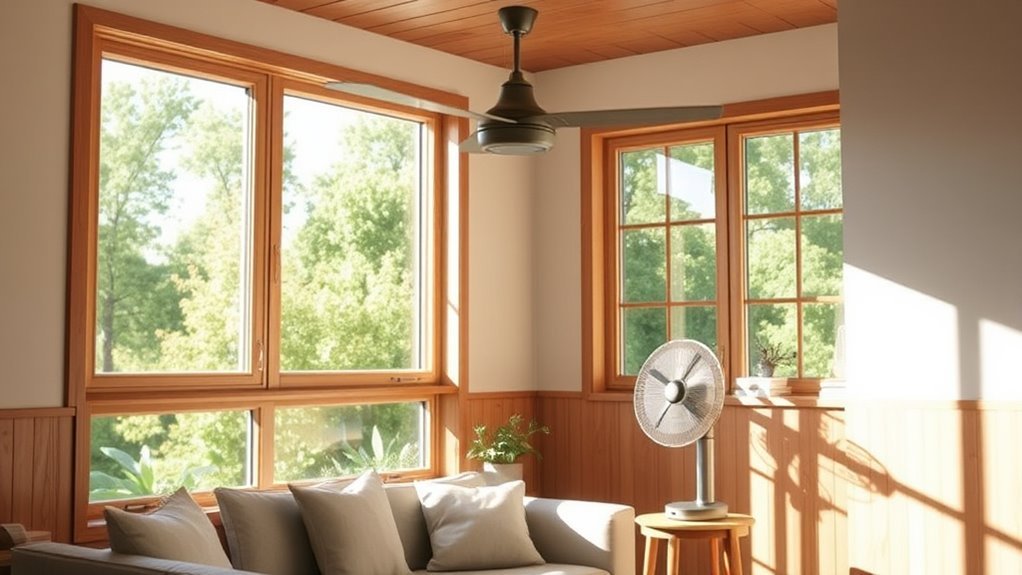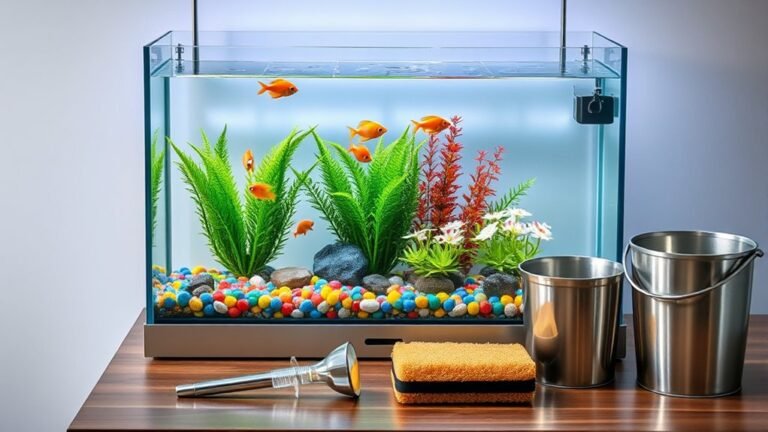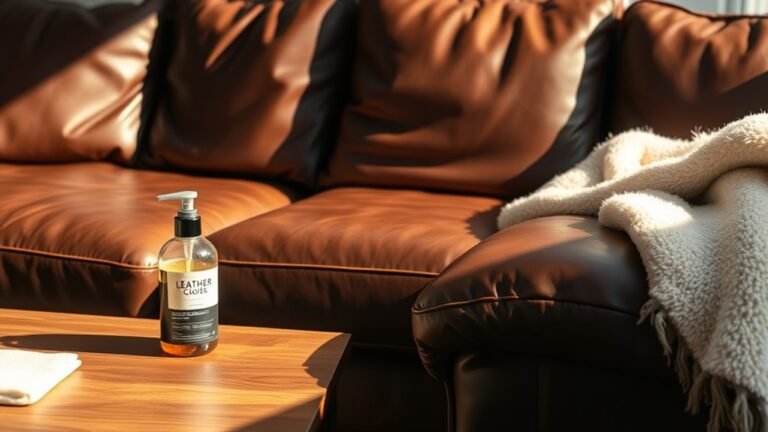Eco-Friendly Alternatives to AC
You can cut cooling energy by using eco-friendly alternatives to AC like passive design that boosts natural airflow and shading, or evaporative coolers ideal for dry climates. Solar-powered systems reduce grid dependence, while geothermal cooling taps the earth’s stable temperature for efficiency. Efficient fans and green roofs lower heat gain, and indoor plants improve air quality naturally. Smart thermostats optimize energy use further. Exploring these scientifically backed methods reveals effective ways to cool sustainably and save energy.
Passive Cooling Design Techniques

Although modern air conditioning offers immediate relief from heat, passive cooling design techniques provide a sustainable alternative by leveraging natural airflow, shading, and thermal mass to regulate indoor temperatures. You can optimize natural ventilation by strategically positioning windows and vents to enhance cross-breezes, reducing reliance on mechanical systems. Thermal mass, such as concrete or brick, absorbs heat during the day and releases it when temperatures drop, stabilizing indoor climate fluctuations. Studies show buildings utilizing these methods can lower cooling energy consumption by up to 50%. By integrating shading devices like overhangs or vegetation, you minimize solar heat gain, further decreasing indoor temperatures. Embracing these techniques not only reduces your carbon footprint but also grants you independence from energy-intensive cooling solutions, aligning with your desire for environmental and personal freedom.
Evaporative Coolers and Swamp Coolers
You’ll find that evaporative coolers reduce air temperature by passing warm air through water-saturated pads, leveraging the thermodynamic process of water evaporation. Swamp coolers offer energy-efficient cooling with considerably lower electricity consumption compared to traditional AC units, especially in dry climates. Understanding their operation and benefits can help you assess their suitability for eco-friendly cooling needs.
How Evaporative Coolers Work
Because evaporative coolers rely on the natural process of water evaporation to reduce air temperature, they operate fundamentally differently from traditional air conditioners. Instead of compressing refrigerants, these devices use evaporative cooling to lower heat by adding moisture to the air, impacting humidity control directly.
Here’s how they work:
- Warm air is drawn through water-saturated pads.
- Water absorbs heat from the air, evaporating in the process.
- This evaporation cools the air, which is then circulated into your space.
- The increase in humidity helps regulate dryness, particularly in arid climates.
Benefits of Swamp Coolers
Understanding how swamp coolers operate provides insight into their practical advantages over conventional air conditioning systems. These devices use evaporative cooling, a process that consumes considerably less electricity than compressor-based AC units, resulting in notable energy savings. You’ll appreciate that swamp cooler maintenance is straightforward—regular pad replacement and water reservoir cleaning minimize mechanical issues and optimize performance. Unlike traditional ACs, swamp coolers introduce fresh air continuously, enhancing indoor air quality and preventing stagnation. Their simple design reduces operational complexity, granting you freedom from costly repairs and high energy bills. However, their effectiveness depends on ambient humidity levels, making them ideal for dry climates. By choosing swamp coolers, you align with eco-friendly practices without sacrificing comfort or autonomy in managing your cooling needs.
Solar-Powered Air Conditioning Systems

You can harness solar energy to power air conditioning systems by converting sunlight into electricity through photovoltaic panels. This method greatly reduces reliance on grid electricity, cutting both energy costs and carbon emissions. Understanding how solar AC integrates with your existing setup reveals its potential for sustainable, efficient cooling.
How Solar AC Works
While traditional air conditioning systems rely heavily on electricity from the grid, solar-powered air conditioning systems harness energy directly from the sun using photovoltaic panels. This process optimizes solar panel efficiency to maximize energy capture. You’ll find these systems typically include:
- Photovoltaic Panels – Convert sunlight into electrical energy with high solar panel efficiency.
- Energy Storage – Batteries store excess power for use during low sunlight periods, ensuring consistent operation.
- Inverter – Converts stored DC energy into AC power compatible with your cooling unit.
- Cooling Mechanism – Uses the converted energy to operate compressors or absorption chillers, providing regulated cooling.
Understanding these components helps you appreciate how solar AC systems offer energy independence by shifting reliance from the grid to renewable solar power.
Benefits of Solar Cooling
Because solar-powered air conditioning systems utilize renewable energy directly from the sun, they greatly reduce your reliance on conventional electricity sources, leading to lower utility costs and decreased carbon emissions. By harnessing solar energy, these systems provide sustainable cooling without the environmental burden associated with fossil fuels. Their efficiency stems from integrating photovoltaic panels with thermally driven cooling technologies, minimizing electrical consumption. You benefit from energy independence, especially in regions with high solar irradiance, ensuring consistent performance during peak demand periods. Furthermore, solar cooling systems reduce grid strain, supporting broader energy sustainability goals. Adopting these systems means you’re investing in a technically advanced solution that aligns with eco-friendly principles while maintaining effective temperature control. This approach empowers you to enjoy comfort without compromising environmental responsibility.
Geothermal Cooling Solutions
Although geothermal cooling solutions require an upfront investment in specialized equipment, they leverage the earth’s stable underground temperature to efficiently regulate indoor climates. By tapping into consistent subterranean temperatures, geothermal systems provide precise temperature regulation with minimal energy consumption. When you adopt this technology, you’re investing in a system that balances efficiency and sustainability.
Consider these key advantages:
- Stable temperature source: The earth maintains a near-constant temperature year-round, enabling reliable cooling.
- Reduced energy use: Geothermal systems consume up to 50% less electricity than conventional AC units.
- Long-term savings: Though installation costs are high, operational savings offset expenses over time.
- Minimal environmental impact: These systems lower greenhouse gas emissions by minimizing fossil fuel dependency.
Energy-Efficient Fans and Ventilation

If you want to reduce energy consumption without sacrificing comfort, energy-efficient fans and ventilation systems offer a practical solution. Modern fans designed with brushless DC motors consume up to 70% less electricity compared to traditional models, directly supporting energy conservation goals. Proper fan placement is essential; positioning fans near windows or doorways enhances cross-ventilation, facilitating effective airflow that lowers indoor temperatures without mechanical cooling. Ceiling fans should rotate counterclockwise in summer to generate a cooling breeze. Additionally, integrating ventilation systems with smart controls allows you to optimize operation based on occupancy and ambient temperature, reducing unnecessary energy use. By strategically combining efficient fan technology with intelligent ventilation design, you gain freedom from high energy bills while maintaining a comfortable indoor environment sustainably.
Green Roofing and Insulation Methods
When aiming to enhance thermal regulation in your building, green roofing and advanced insulation methods play a critical role. Green roofing benefits include reducing heat absorption and providing natural cooling through vegetation layers, which lower rooftop temperatures by up to 40%. Choosing the right insulation materials further prevents heat transfer, maintaining indoor comfort without excessive energy use. Consider these key factors:
Green roofing and quality insulation significantly reduce heat absorption, enhancing building comfort and energy efficiency.
- Use eco-friendly insulation materials like cellulose or sheep’s wool for effective thermal resistance.
- Incorporate reflective roof coatings to minimize solar heat gain.
- Implement green roofs with drought-resistant plants to optimize evapotranspiration.
- Guarantee high-density insulation to reduce thermal bridging in walls and roofs.
Indoor Plant Placement for Natural Cooling
Since indoor plants influence humidity and air temperature through transpiration, their strategic placement can greatly enhance natural cooling in your space. By focusing on plant selection and ideal positioning, you control humidity and temperature regulation effectively. Consider light exposure and natural habitat to align with growth patterns, ensuring seasonal changes don’t impair cooling efficiency or aesthetic appeal. Proper placement also improves air quality, contributing to a healthier indoor environment.
| Aspect | Consideration | Impact |
|---|---|---|
| Plant Selection | Native species, transpiration rate | Enhanced cooling, air quality |
| Ideal Positioning | Near windows, shaded areas | Maximized temperature regulation |
| Seasonal Changes | Adjust for growth patterns | Maintains humidity control, aesthetic appeal |
This approach frees you from energy reliance and maximizes natural, sustainable cooling.
Smart Thermostats and Energy Management
Although traditional thermostats offer basic temperature control, smart thermostats provide advanced energy management by learning your schedule and preferences. Integrating a smart thermostat into your smart home system can greatly enhance your energy savings without sacrificing comfort. Here’s how:
- Adaptive Scheduling: Automatically adjusts temperatures based on your daily routines, reducing unnecessary cooling.
- Remote Access: Lets you control settings via smartphone, ensuring your home isn’t overcooled when unoccupied.
- Energy Usage Reports: Provides data-driven insights to optimize consumption patterns and identify inefficiencies.
- Integration with Sensors: Uses occupancy and humidity sensors to fine-tune HVAC operation, minimizing waste.
Frequently Asked Questions
How Do Eco-Friendly Cooling Methods Affect Indoor Air Quality?
When you use eco-friendly cooling methods, natural ventilation can greatly improve indoor air quality by increasing airflow and reducing pollutant buildup. However, without proper humidity control, you might face issues like mold or discomfort. Evidence shows that combining ventilation with humidity regulation maintains healthier, fresher air, offering you freedom from stale environments. So, managing both factors technically guarantees your space feels clean and comfortable while staying eco-conscious.
Are There Government Incentives for Installing Green Cooling Systems?
Yes, you can often access government rebates and tax credits when installing green cooling systems. These incentives are designed to lower your upfront costs and encourage energy-efficient upgrades. By leveraging these financial benefits, you not only reduce your environmental footprint but also gain cost savings over time. It’s a strategic move that enhances your control over energy expenses while supporting sustainable technology adoption, aligning with your desire for both freedom and responsible energy use.
What Maintenance Is Required for Eco-Friendly Cooling Alternatives?
They say, “a stitch in time saves nine,” and that’s true for your cooling system. To keep it running efficiently, you’ll need regular check ups to identify issues early. Seasonal cleaning is essential—clearing filters and ducts improves airflow and energy use. These technical steps prevent breakdowns and maintain performance, giving you freedom from costly repairs. Staying proactive guarantees your system operates at peak efficiency, saving energy and supporting your sustainable lifestyle.
Can These Alternatives Be Integrated With Existing HVAC Systems?
Yes, you can definitely explore integrated solutions that combine eco-friendly cooling methods with your current HVAC system. Hybrid systems allow you to optimize energy use by switching between traditional and sustainable cooling based on demand. This integration enhances efficiency and offers you greater control, ultimately freeing you from high energy costs and environmental impact. Technical assessments confirm that retrofitting existing setups with such hybrid configurations is both feasible and beneficial.
How Do Eco-Friendly Cooling Costs Compare to Traditional AC Units?
When you conduct a cost analysis comparing eco-friendly cooling to traditional AC units, you’ll find upfront expenses for eco-friendly systems can be higher. However, energy savings over time often offset these initial costs, reducing your overall expenditure. By choosing efficient technologies, you gain long-term financial freedom through lower utility bills and maintenance. This evidence-based approach empowers you to make an informed decision that balances initial investment with sustainable savings.






